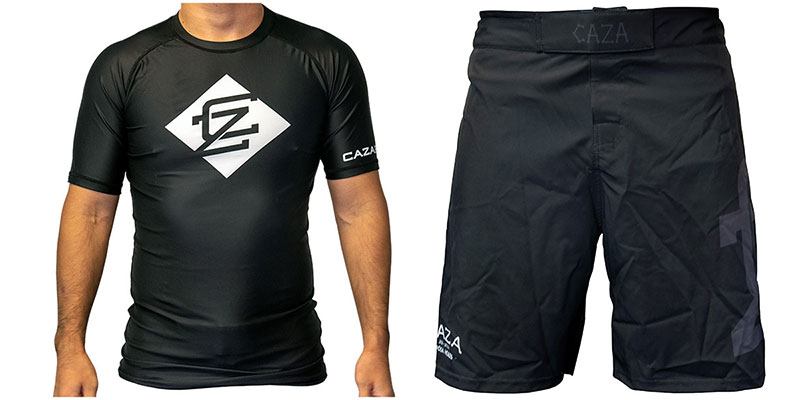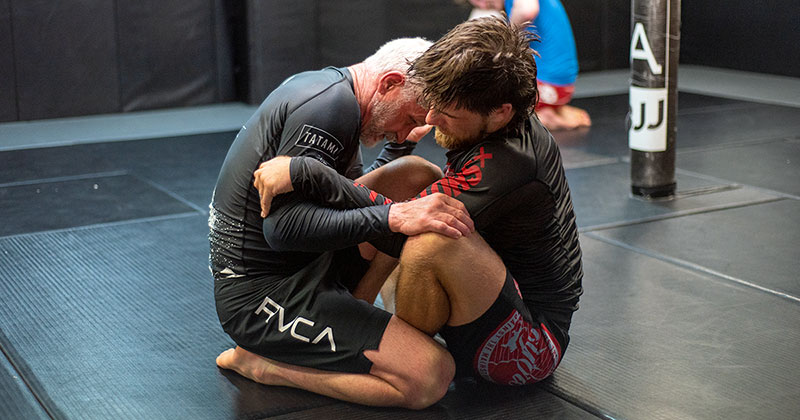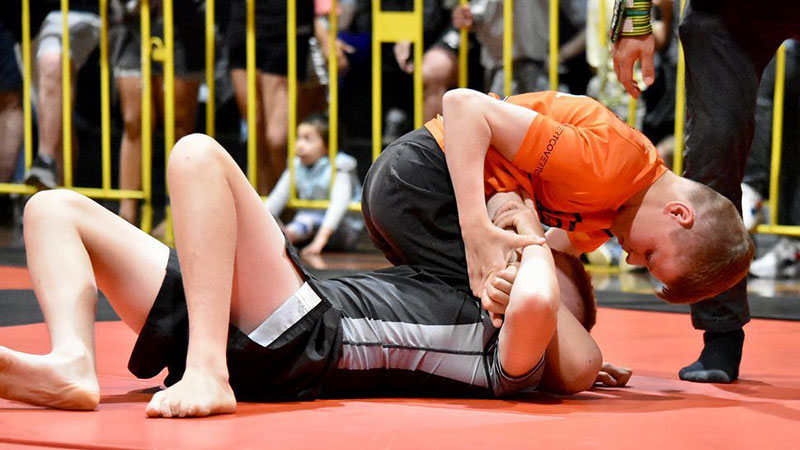If you are familiar with Brazilian Jiu-Jitsu at all you will be aware that there are two ways to train or compete in the sport – in a gi and alternatively, no gi. The word ‘gi‘ is the name for the traditional uniform worn by a BJJ student (all known by their Japanese name: kimono).
Below we will look more closely at the no gi version of Brazilian Jiu-Jitsu. We may refer to this simply as no gi jiu-jitsu for brevity.

No gi vs gi Jiu-Jitsu: What are the differences?
The main differences between the two types of training can be separated into several categories which we will look at in turn.
Uniform differences
The uniforms look completely different, obviously, but let’s look at some of the details for each.
Traditional Gi uniforms
The traditional Brazilian Jiu-Jitsu uniform, called a gi, looks like your typical Japanese martial arts uniform (this is why the word kimono persists). BJJ gis are thicker than most other martial arts uniforms and more similar to a Judo gi than, say, a karate uniform. Judo is another sport dependant upon strong grips.
The belts, while different in colour, are like those used in other martial art.
No gi uniforms
A no gi uniform is little more than shorts and a rashie (rash guard) made from quick-dry materials. Many BJJ competitions require combatants to wear a rashie colour that matches their current belt rank.
An important feature of the shorts is that they cannot have pockets, or any other features that may catch fingers or toes. Board shorts are often banned for this reason.

You will find no gi training to be quite a sweaty experience!
The differences in techniques
There is significant overlap between no gi and gi jiu jitsu. They are the same sport after all. But because there are clear rules prohibiting the grabbing of any part of a no gi uniform (this is a key difference), the two styles have several distinctions in practice.
Gi BJJ
Gi BJJ often involves taking advantage of the grips that you can take on your opponent’s gi. There are some limitations, such as putting your fingers inside the cuffs of the sleeves or pants, but generally speaking, you can grab your opponent’s gi. Many BJJ chokes rely purely on this opportunity.
No gi BJJ
Because grabbing the uniform is banned in no gi grappling, you need to learn different ways of gripping your opponents limbs. You will learn terms like ‘monkey grip‘ and hear them being used often, for example.
You will see (and experience) more attacking of the feet and ankles in no gi since these are most exposed in a no gi jiu jitsu fight.
A rash guard wouldn’t make for much of a grip, even it were permitted. But don’t be tempted, especially in a tournament – it will get you DQ’ed (disqualified)!

There is often heated debate over which training is better in real life situations or a street fight. The same comparison is frequently made with most popular martial arts.
Friction differences
Another more subtle difference is friction. There is far less friction in no gi which allows you to escape some positions and submission attempts that you wouldn’t be able to wriggle out of in a gi.
If you ever experience no gi training in a hot gym you will really notice the difference. Grips can be very difficult to maintain when everyone is sweaty.
Differences in rules between gi and no gi competitions
Each BJJ organisation, such as the IBJJF, has it’s own rule book. In those rules books there are whole sections dedicated to both gi and no gi competition, which we won’t reiterate in detail here. We have, however, listed the key differences below:
- Most gi grips are permitted in gi jiu jitsu. No uniform grips are allowed in no gi.
- The belt is part of a your uniform in a gi match and must remain tied on at all times.
- Gis and rashies are often restricted in competition in terms of their colour. For example, gis are often limited to being black, white or royal blue in gi jiu jitsu tournaments. Conversely, rashies must reflect your current belt colour at many tournaments.
- Because the uniforms are so different, they also cause a change in the weight limits for BJJ competitors.

Advantages of no gi training
No gi training tends to attract a wide range of people. They may have an interest in competing one day at events such as those run by the Abu Dhabi Combat Club (ADCC Submission Fighting World Championship) or perhaps they subscribe to the idea that no gi training better reflects a self defence situation.
Both gi and no gi BJJ classes will give you the opportunity to practice a broad range of techniques. But if you have a particular interest in no gi only, great! Do what makes you happy.
A martial art like no gi jiu jitsu will provide a fantastic focal point in your life where the learning never ends. It is exciting, it is fast and your grappling game will become sharp.
Grappling with an opponent without a gi is great for any BJJ practitioner who has become dependant on gi grips to be effective on the mats. The skills you will need to focus on in no gi may not be your favourites when you train in a gi, so going out of your comfort zone might be just what you need.
The current trend in high level no gi is to frequently attack feet and ankles and look for submissions there. Of all the techniques available, heel hooks are seemingly the most popular no gi jiu jitsu submission.
Jiu-Jitsu is also extraordinary good for your fitness levels if you are able to regularly train.
Is gi or no gi better for self-defence?
It is a reasonable question. But is there a good answer?
Someone who has moved beyond BJJ beginner in either gi or no gi jiu jitsu is in a good position to defend themselves against an opponent in competition or in the street.
Unless you have a profession where you are frequently in physical altercations, it will be hard to predict what you will be wearing should you find yourself in a fight. Will you be at a beach carpark wearing a pair of shorts or a bikini, or will you be in a suit at the door of a nightclub? Who knows.
In the eternal debate between the hardcore gi and the hardcore no gi supporters, good points can be made by both sides. A t-shirt might not be useful to someone proficient with collar chokes, but if they catch someone in a collared shirt or a jacket, well, it’s sleepy time.
Our recommendation is that you attend as many BJJ classes as possible. Master the techniques shown and incorporate them into your training. Both gi and no gi have so much to offer; don’t restrict your skills because of a trivial debate.
No gi vs gi Jiu-Jitsu for beginners
When you start out as a BJJ beginner you shouldn’t choose one or the other, as the points above suggest. You should focus on learning as much technique as possible so that your sparring sessions can be more productive sooner.
As the range of techniques that you can effectively use grows, you will find that most are useful regardless of whether you are training in a gi or not.
Beginners are probably better served by attending gi classes initially. The reason being is that gi training is far more technical overall whereas no gi is more of an included subset of gi BJJ. The body mechanics are mostly the same and you will pick up valuable skills either way.
As you train more and your skills develop, you may find that you have a preference for gi or no gi. Until then however, just focus on your technique, your grappling and your submissions. The rest will come with time.
Is gi or no gi better for MMA?
MMA, or mixed martial arts, is clearly more akin to no gi BJJ as far as the jiu jitsu goes. The same lack of grips applies and so there is a close similarity there. But that doesn’t mean an aspiring MMA fighter should avoid the gi.
Learning to roll in a gi is crucial to anyone serious about Brazilian Jiu-Jitsu. Even if you never compete in a gi. There is a lot to learn in Brazilian Jiu-Jitsu while wearing a gi and you can always peel back the huge range of techniques you’ve learned in a gi to suit any type of no gi competition. That said, a successful mixed martial artist may never pull on a BJJ gi.
You will need to spend a significant amount of time mastering no gi grips for MMA. Controlling an opponent who is wearing very little, is sweaty and while you are wearing gloves is difficult. Applying a submission attempt under these conditions is equally trying. No gi BJJ is therefore great for this part of your training.
Because a gi doesn’t appeal to some people who aspire to be an MMA fighter, many of them will refer to themselves simply as grapplers. Grappling is also a term also used by wrestlers, so someone calling themselves a grappler may never have stepped into a BJJ gym.
You should be comfortable with no gi BJJ before ever agreeing to an MMA fight. It is an essential skillset for modern MMA combatants since these fights often end up on the ground in a mad scramble for control.
There are many things taught in Brazilian Jiu-Jitsu that you should never do when striking your opponent is allowed. For example, something as trivial as closing your guard is a really bad idea in MMA, but its something a BJJ student might do automatically. Your MMA coach will teach you the dos and don’ts of grappling for this sport.
Your grappling style needs to be fit for purpose. MMA fighters have different considerations and no one style is perfect for every situation.

